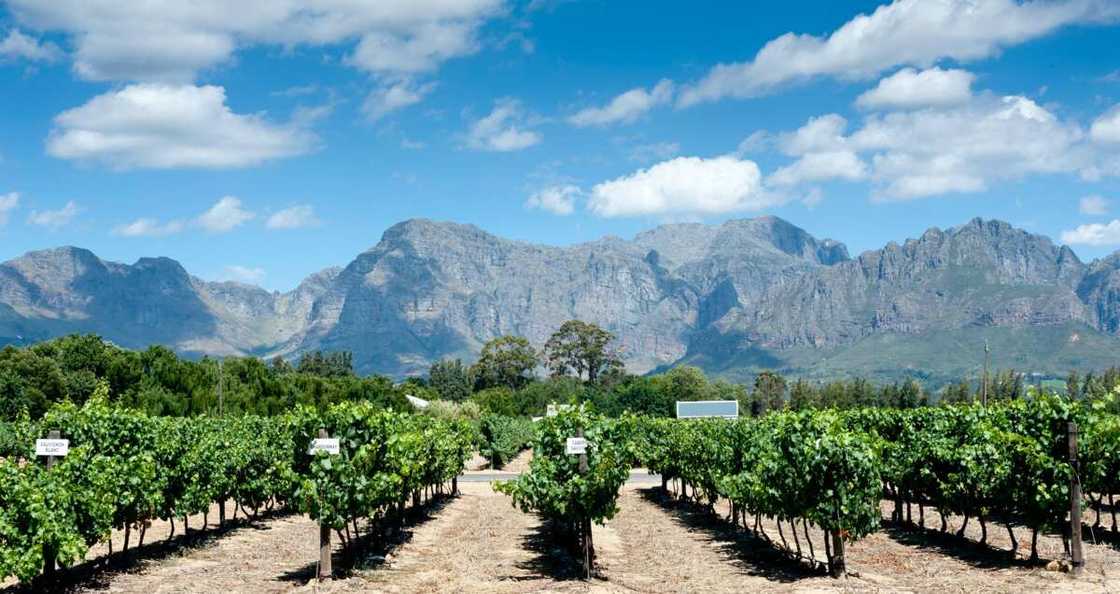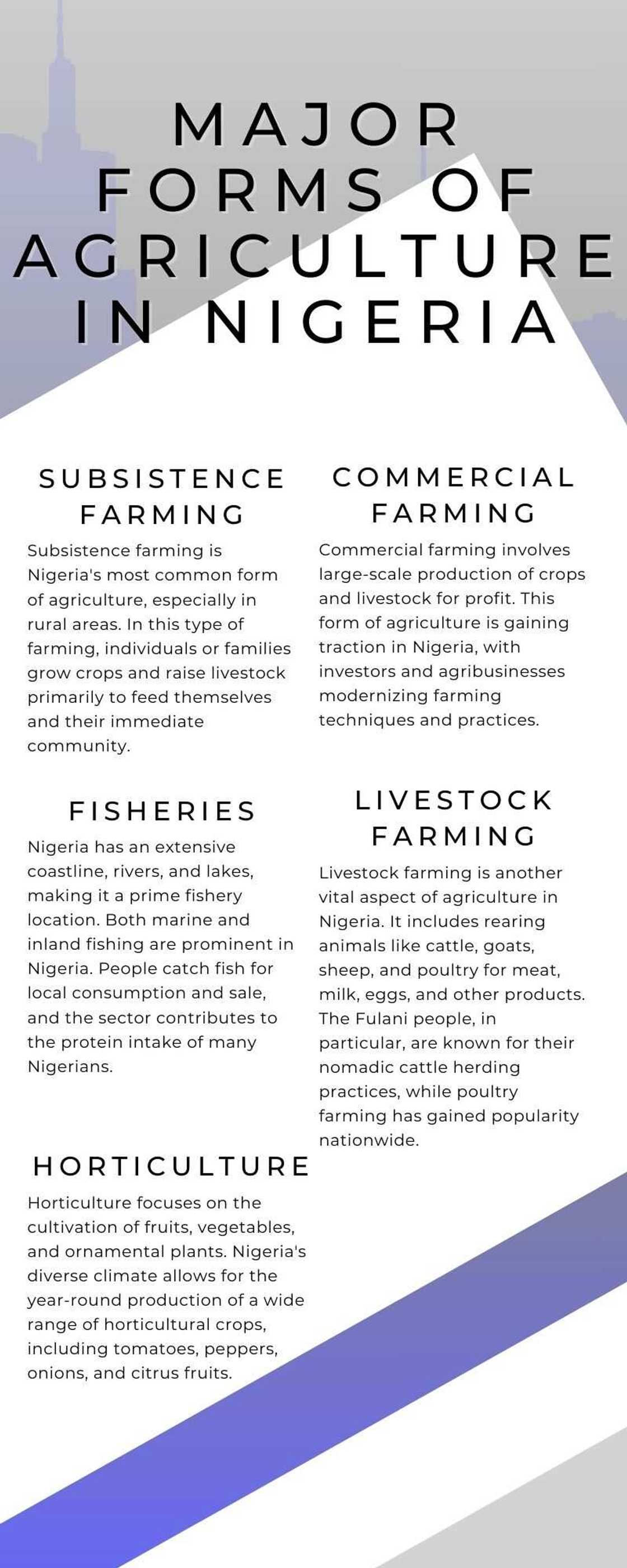What are the major forms of agriculture in Nigeria? Find out now
Nigeria's climate is perfect for different forms of agriculture. The country is geographically located in the tropical zone. The local weather conditions are good for growing vegetables in different parts of the country and perfect for cultivating various types of crops in many areas.

Source: UGC
Agriculture is the backbone of Nigeria's economy, providing livelihoods for millions of people and contributing significantly to the country's GDP. Nigeria's diverse climate and geography allow for various agricultural activities.
What is the meaning and type of agriculture in Nigeria?
Agriculture is the practice of cultivating and breeding plants, animals, and other organisms for food, fibre, medicinal plants, and other products used to sustain and enhance human life.
Agriculture in Nigeria encompasses all the activities involved in the cultivation of crops, the raising of livestock, and the management of fisheries and forestry.
Each part of the country has its features in terms of agriculture. For example, the Southern areas of Nigeria have long rains, and such humidity works well for growing cocoa, coffee, potatoes, melon, cotton, rice, etc.
The areas in the Eastern part of Nigeria and near the coast have too much rain, which leads to soil erosion and the inability to plant palms, cocoyam, etc. The Northern areas are mostly used for cultivating livestock. You can find horses, donkeys, camels, goats, sheep and other animals here.
What are the different forms of agriculture?
The agricultural sector in Nigeria is crucial for ensuring food security by producing staple crops and livestock. Here are the major forms of agriculture in Nigeria.
1. Subsistence farming
Subsistence farming is Nigeria's most common form of agriculture, especially in rural areas. In this type of farming, individuals or families grow crops and raise livestock primarily to feed themselves and their immediate community.
The produce is often not sold in the market but used for personal consumption. Common crops include yams, cassava, maize, and vegetables.
2. Commercial farming
Commercial farming involves large-scale production of crops and livestock for profit. This form of agriculture is gaining traction in Nigeria, with investors and agribusinesses modernizing farming techniques and practices. Commercial farming often incorporates advanced technology, machinery, and modern agricultural practices.
3. Fisheries

Source: UGC
Nigeria has an extensive coastline, rivers, and lakes, making it a prime fishery location. Both marine and inland fishing are prominent in Nigeria. People catch fish for local consumption and sale, and the sector contributes to the protein intake of many Nigerians.
4. Livestock farming
Livestock farming is another vital aspect of agriculture in Nigeria. It includes rearing animals like cattle, goats, sheep, and poultry for meat, milk, eggs, and other products. The Fulani people, in particular, are known for their nomadic cattle herding practices, while poultry farming has gained popularity nationwide.
5. Horticulture
Horticulture focuses on the cultivation of fruits, vegetables, and ornamental plants. Nigeria's diverse climate allows for the year-round production of a wide range of horticultural crops, including tomatoes, peppers, onions, and citrus fruits.
6. Apiculture
Apiculture, also known as beekeeping, involves cultivating and maintaining bee colonies to harvest significant quantities of honey, beeswax, and various bee-related products. These valuable bee-derived items primarily serve human purposes and have many applications.
7. Snail rearing
Snail rearing, also known as heliculture, is a growing agricultural practice in Nigeria. It involves the controlled breeding and management of snails, particularly the African giant land snail (Achatina species), for various purposes, including consumption and commercial production.
What are the 5 types of agriculture in Nigeria?

Source: UGC
Nigeria has various types of agriculture due to the country's diverse climate, geography, and cultural practices. The five primary types of agriculture in Nigeria include:
- Subsistence agriculture
- Commercial agriculture
- Livestock farming
- Fisheries
- Horticulture
What are the forms of agriculture in Nigeria?
Besides the above five primary types, there are other notable forms and practices of agriculture in Nigeria, including:
- Forestry
- Organic farming
- Apiculture
- Snail rearing
What are 3 traditional crops and natural resources in Nigeria?
The traditional crops in Nigeria are:
- Yams
- Cassava
- Palm oil
The three major natural resources in the country include:
- Petroleum and natural gas
- Solid minerals
- Forests and timber
What are the major cash crops produced in Nigeria?
The major cash crops in Nigeria include oil palm, cotton, cocoa, cassava, Rubber, yam, cashew nuts and ground nuts. These crops are crops grown primarily for sale in the market.
What is the importance of agriculture in Nigeria?
Agriculture provides food security for the nation's growing population and is a vital driver of economic growth, employment, and rural development. It also contributes significantly to the country's GDP and offers livelihoods for many of the population.
These are the major forms of agriculture in Nigeria. These forms, to a large extent, depend on the economic situation in the country. Each form contributes to the country's food security, job creation, and economic growth.

Source: UGC
Legit.ng recently published a list of NGOs in Nigeria and outlined their activities. These non-governmental organizations primarily aim to enhance the quality of life for individuals by offering various services without cost.
Nigeria hosts numerous international NGOs, with a significant portion affiliated with the Nigeria Network of NGOs. These NGOs are divided into various areas and serve different purposes.
Source: Legit.ng






